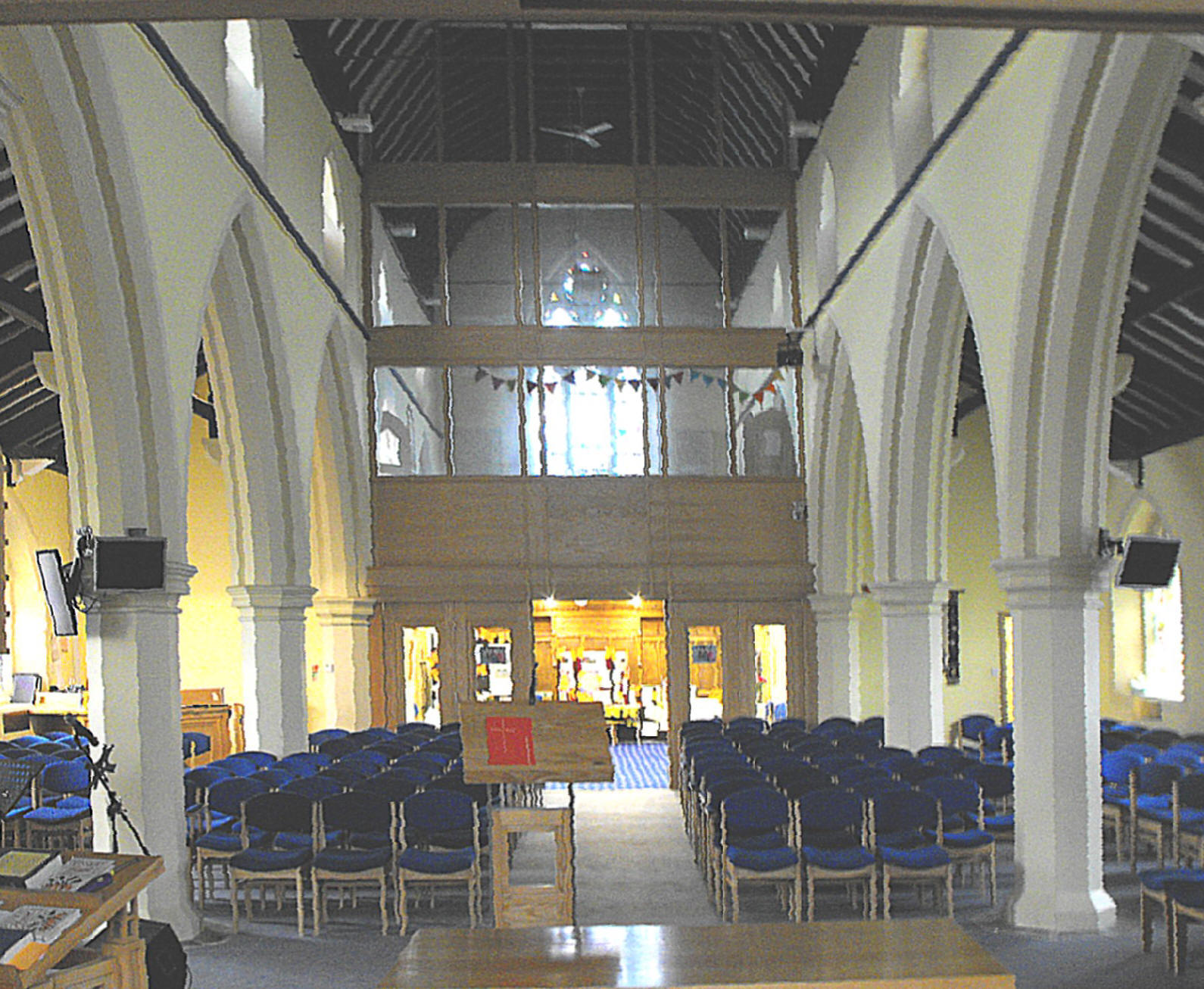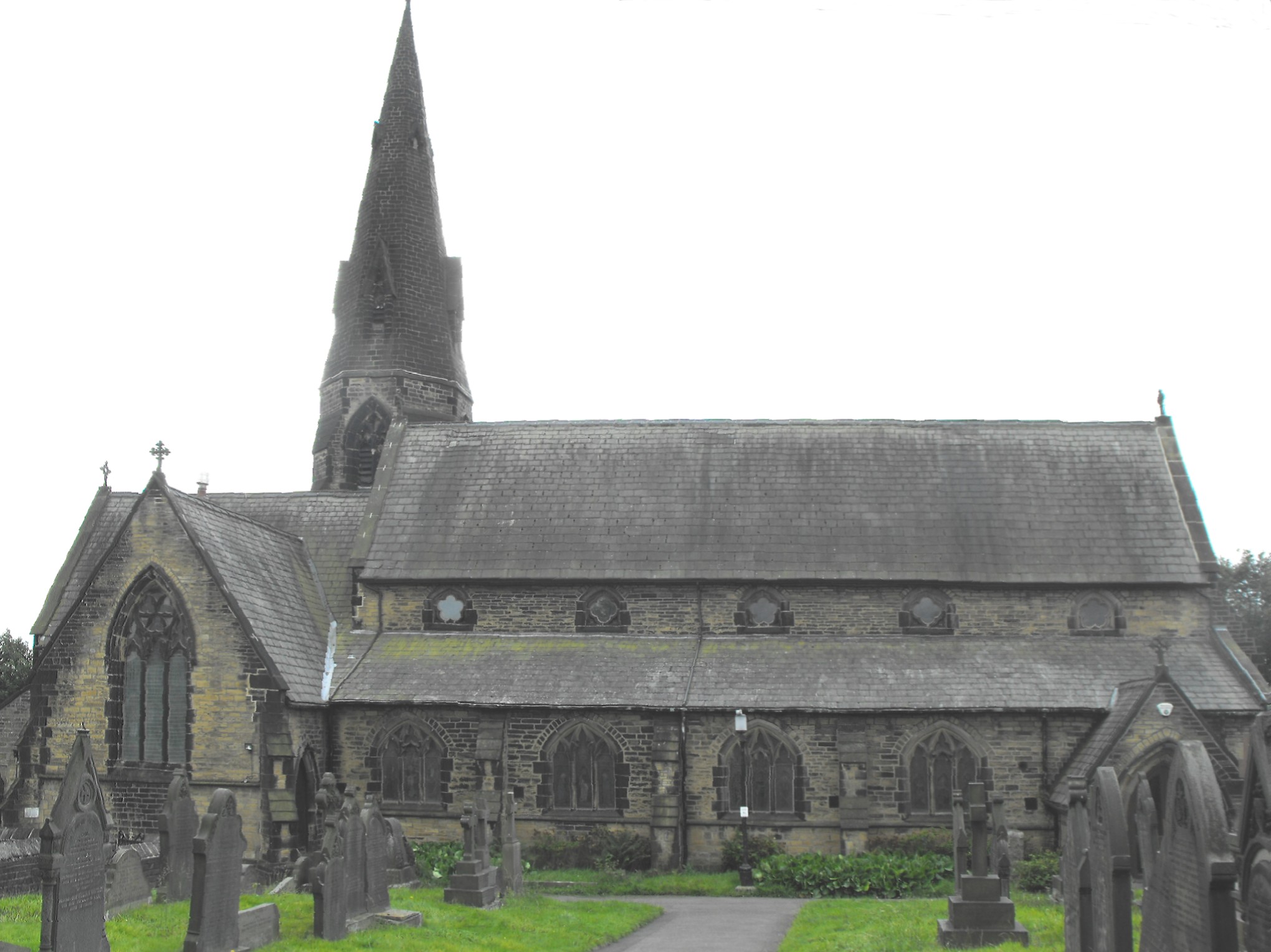|
(« back to home
page)
English Church Architecture.
SALTERHEBBLE (HALIFAX), All Saints
(SE 093 227),
CALDERDALE.
(Bedrock:
Carboniferous Namurian Series, Rough Rock from the Millstone Grit Group.)
Another
inexpensive church by Mallinson and Healey, set proudly on a ridge.
|
One of the subjects examined by this
web-site is the near-complete oeuvre of a little-known but regionally
dominant, mid-nineteenth century architectural firm specialising in
ecclesiastical work, in order to discover how they built their local reputation,
how they maintained a financially competitive edge and sustained a very busy
practice with few or no staff, and what 'success' looked like in terms of
monetary reward and the provincial architect's acquired position in
Victorian society. The firm chosen is the partnership between James
Mallinson and Thomas Healey (fl. 1845-62/3), who worked out of offices in
Halifax and Bradford. The majority of the extant church buildings for which the
partners were responsible are listed below and should ideally be examined in
chronological order. They are:
|
1. Queensbury, Holy Trinity
(Bradford) (1843) (Mallinson
alone) |
19. East Keswick, St. Mary Magdalene
(Leeds) (1856) |
|
2. Wyke, St. Mary (Bradford)
(1844) (Mallinson alone) |
20. Claremount, St. Thomas (Calderdale)
(1857) |
|
3. Clayton, St. John the Baptist
(Bradford) (1846) |
21. Clifton, St. John (Calderdale)
(1857) |
|
4. Baildon, St. John the Baptist
(Bradford) (1846) |
22. Salterhebble, All Saints
(Calderdale) (1857) |
|
5. Manningham, St. Paul (Bradford)
(1846) |
23. Thornaby-on-Tees, St. Paul
(Stockton-on-Tees) (1857) |
|
6. Mytholmroyd, St. Michael
(Calderdale) (1847) |
24. Thornhill Lees, Holy Innocents
(Wakefield) (1858) |
|
7. Bankfoot, St. Matthew (Bradford)
(1848) |
25. Bugthorpe, St. Andrew (East Riding)
(1858) (nave only) |
|
8. Shelf, St. Michael & All Angels
(Bradford) (1848) |
26. Bowling, St. Stephen (Bradford)
(1859) |
|
9. South Ossett, Christ Church
(Wakefield) (1850) |
27. Girlington, St. Phillip (Bradford)
(1859) |
|
10. Barkisland, Christ Church
(Calderdale) (1851) |
28. Lower Dunsforth, St. Mary (North
Yorkshire) (1859) |
|
11. Boroughbridge, St. James (North
Yorkshire) (1851) |
29. Welburn, St. John (North Yorkshire)
(1859) |
|
12. Langcliffe, St. John the Evangelist
(North Yorkshire) (1851) |
30. Ilkley, All Saints (Bradford) (1860)
(chancel only) |
|
13. Cundall, St. Mary & All Saints
(North Yorkshire) (1852) |
31. Horton, All Saints (Bradford)
(1862) |
|
14. Heptonstall, St. Thomas the Apostle
(Calderdale) (1853) |
32. Hepworth, Holy Trinity (Kirklees)
(1862) |
|
15. Mount Pellon, Christ Church
(Calderdale) (1854) |
33. Dewsbury, St. Mark (Wakefield)
(1862) |
|
16. Thorner, St. Peter (Leeds) (1854)
(partial reconstruction) |
34.
Heaton, St. Barnabas (Bradford) (1863)
(Mallinson with T.H. Healey)
|
|
17. Withernwick, St. Alban (East Riding)
(1854) (reconstruction) |
35. Tockwith, Church of the
Epiphany (North Yorkshire) (1863) (as
above) |
|
18. Mappleton, All Saints (East Riding)
(1855) (not the tower) |
|
|
 This
is a large and rather plain church by Mallinson and Healey,
given some interest by its tall diagonally-buttressed southeast tower
with octagonal bell-stage, surmounted by a spire lit by two tiers of
gabled
lucarnes, rising directly from the walls of the bell-stage below. (See
the photographs, left, taken from the southwest, and at the foot of the page, taken from
the north.) The rest of the building consists of a chancel
with a cross-gabled N. chapel and adjoining vestry, and a five-bay nave
with lean-to aisles and a N. porch. Inside, a mezzanine floor
added recently over the western bays of the nave, creates an enclosed space above. This
is a large and rather plain church by Mallinson and Healey,
given some interest by its tall diagonally-buttressed southeast tower
with octagonal bell-stage, surmounted by a spire lit by two tiers of
gabled
lucarnes, rising directly from the walls of the bell-stage below. (See
the photographs, left, taken from the southwest, and at the foot of the page, taken from
the north.) The rest of the building consists of a chancel
with a cross-gabled N. chapel and adjoining vestry, and a five-bay nave
with lean-to aisles and a N. porch. Inside, a mezzanine floor
added recently over the western bays of the nave, creates an enclosed space above.
Thomas Healey adopted the late geometrical style here
in 1857, for tracery shapes are confined largely to trefoils and
quatrefoils (some of them pointed), with only a few small ogees
creeping in here and there. The latter were probably not
prominent enough to offend Ruskin's disciples (as discussed under
the entry for Bankfoot)
although the building is not particularly reflective of other
Ruskinian dogmas for there is no constructional colour, the masonry all
being cut from
the same local sandstone, and no obvious privileging of mass over
line (as there is, for example, at St. Barnabas's, Heaton). The nave arcades are composed of double-flat-chamfered
arches springing from octagonal piers (as seen below left in the
view looking west), the chancel arch and N. chapel arch from the
chancel bear two flat chamfers above semi-octagonal responds, and the chamfers around the arch to the
organ chamber opposite in the base of the tower, die
into the jambs. The nave roof is framed in seven cants with
ashlar pieces rising from the wall plates, braced collars and no
purlins; the chancel roof has purlins at
the
⅓ and ⅔
stages, and collars halfway up the pitch, supported by cusped arch
braces.


Decorative work is confined to two areas in the
church - the font,
and the E. wall of the sanctuary. The former, of 1886
(britishlistedbuildings website), has an octagonal bowl
carved with small figures (or are they Biblical scenes?) on the
cardinal sides and foliage on the ordinal sides, although the
mottled brown and cream marble of which it is made, confuses the
impression it makes on the eye. The E. wall of the sanctuary is a
surprisingly rich conceit in view of the austerity of the church
elsewhere and features a row of nine septfoil-cusped arches at dado
level, with steep crocketed gables rising from figure label stops,
supported below on little brown marble shafts with deeply carved leaf
capitals. There is also some attractive Victorian glass in
some of the windows, most notably the four-light chancel E. window
featuring the Evangelists (shown
above right). There is nothing else that needs particularising,
but this was another confident example of Mallinson and Healey’s
budget-price churches erected in a prominent position on a hilltop
and it presents a proud silhouette against the skyline for
passengers approaching Halifax along the
railway line below the ridge to the southeast.

|


